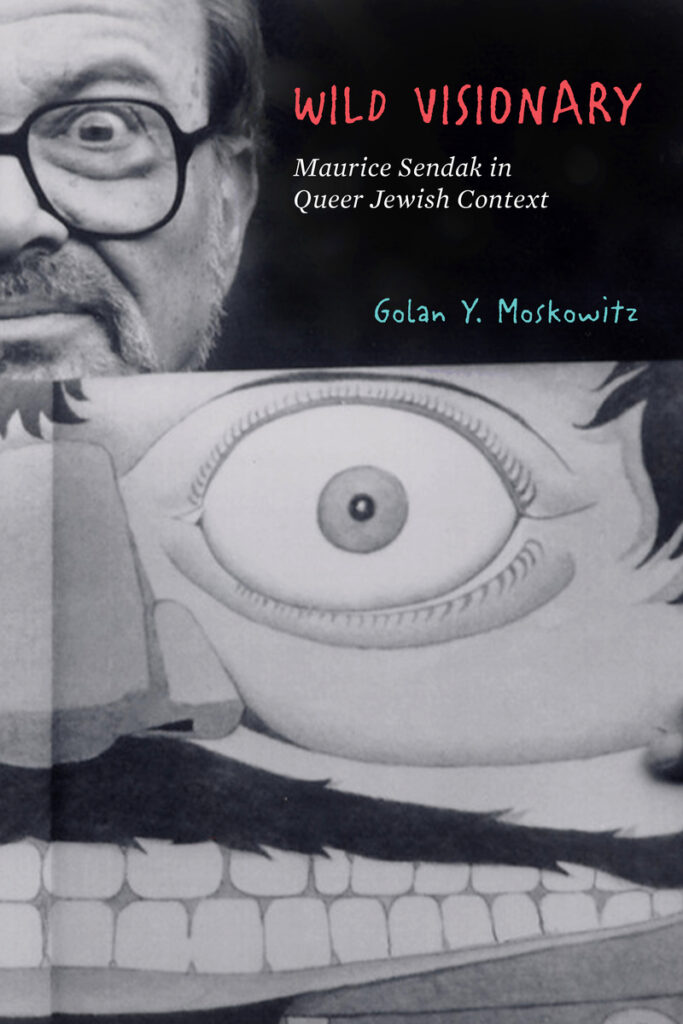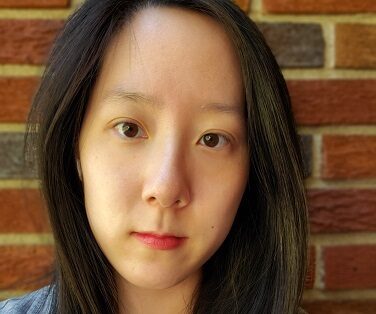Golan Moskowitz is Assistant Professor of Jewish Studies at Tulane University in New Orleans, Louisiana. He is a literary scholar, cultural historian, and visual artist who works at the intersection of modern Jewish studies, gender and queer studies, and trauma and memory studies. Moskowitz has published works on Jewish comics and graphic novels, on queer-studies approaches to intergenerational Holocaust memory, and on the life and work of Maurice Sendak. He is the author of Wild Visionary: Maurice Sendak in Queer Jewish Context (Stanford University Press, 2020).
I had the opportunity to interview Golan, which you can read below.
First of all, welcome to Geeks OUT! Could you tell us a little about yourself?
Thank you, and sure! I grew up in a Jewish Israeli-American family in upstate New York (in Albany and Saratoga Springs). After high school, I majored in visual art at Vassar College and went on to complete graduate studies at Brandeis University (a joint MA in gender studies & Jewish studies, followed by a Ph.D. in Jewish studies). I’m currently based in New Orleans and live with my partner, Trey, who is a music educator and choral conductor.
How would you describe what you do professionally/academically?
I’m a cultural historian and literary scholar who works on twentieth- and twenty-first-century queer Jewish creativity, intergenerational memory and trauma, and Jewish American popular culture. My current professional title is assistant professor of Jewish Studies at Tulane University, where I teach courses on Holocaust film and literature, Jewish comics and graphic novels, Jewish American pop culture, and sexuality in Jewish culture. I’m also a core faculty member of Tulane’s Grant Center for the American Jewish Experience.
What can you tell us about your most recent book, Wild Visionary: Maurice Sendak in Queer Jewish Context? What was the inspiration for this project?
As a queer child of an immigrant, a grandchild of Holocaust survivors, and a visual artist who had been raised on Sendak’s picture books and who loved them, I always felt a sort of kinship with him. This feeling was magnified after learning that his youth was overshadowed by social and emotional challenges related to growing up in a Yiddish-speaking Jewish-American family while news of their relatives’ deaths in the Holocaust was emerging. My interest in Sendak further grew after he publicly “came out” to the mainstream press as gay in 2008 at age 80. Despite coming out, however, his sexuality continued to feel like a sort of “open secret.” When he passed away in 2012, I was a Ph.D. student looking for a dissertation topic, and Sendak’s obituaries and tributes to him were circulating widely. He was on many of our minds at that moment in time, and it seemed to me that his specifically queer accomplishments and legacy were not being substantively addressed and that these must surely be intertwined with his Jewishness, which was such a crucial part of how he understood himself in general. As a Jewish studies student interested in visual art, intergenerational relationships within American immigrant families, Holocaust studies, and queer childhood studies, Sendak seemed a perfect subject on which to base my dissertation project, which would become the basis of this book.
For those who are familiar with Where the Wild Things Are but unfamiliar with Maurice Sendak’s life, what facts did you come across in your research that seemed the most surprising/interesting to you?
Beyond the widely-publicized fact that the Wild Things drew inspiration from Sendak’s unkempt immigrant relatives who both loved and frightened him during his childhood, I was interested to learn that Sendak’s initial idea for Where the Wild Things Are emerged during psychoanalysis (with Bertram Slaff, who was also gay and Jewish). And that Sendak authored the text to this story on Fire Island, a region that was known both for its family-oriented Jewish communities and for its gay and lesbian communities. I was also surprised to learn more about Sendak’s experience living discreetly as a young gay man in the early 1950s in Hell’s Kitchen. On a more general note, I was struck by Sendak’s contributions as a mentor to other important artists, including other gay Jewish artists like Brian Selznick.
As a scholar, why do you believe it’s important to highlight the queer and Jewish elements of this author’s life in the context of his work?
Sendak claimed that much of his work was concerned with excavating, processing, and sometimes exorcising difficult feelings experienced in his youth, which, as I learned, was an undeniably Jewish and queer youth. Queerness and Jewishness, as forms of difference in broader social contexts, may both relate to Sendak’s works’ central themes of loneliness, hybridity, self-transformation and performativity, sometimes-invisible forms of turmoil, emotional resilience, and unlikely heroism. Additionally, the twentieth century, in which Sendak came of age and matured as an artist, saw world-shaking changes in relation to Jewish and queer experience, impacting Sendak’s creative consciousness (i.e. Nazism and the Holocaust, unprecedented levels of acceptance of Jewishness in mainstream American culture, the Gay Liberation Movement, the AIDS crisis, etc.).
As an author, what drew you to writing, specifically non-fiction?
I’ve known since elementary school that I enjoy writing. Possibly because I was shy around most people and felt more comfortable expressing myself to others when given the time and space to first find the right words. This might relate to having been raised by a mother who was not a native English speaker and who loved reading. From an early age, she would take my sisters and me to the library regularly to choose books to read, and we would talk about them together. Writing about books in school felt like an extension of this, and I was fortunate to have teachers who recognized and nourished my writing capacities.
How would you describe your writing process?
I tend to shovel pieces of inspiration (article links, cited quotes, my own short musings) into separate Word documents organized into subsections by topic, sometimes color-coding them to differentiate content. I use these as connectors and building blocks as I free-write within those subsections about ideas or tensions that emerge, and when one idea begins to “take off,” I might create a new section or document for it to grow larger. A handful of these “idea documents” can later amount to sections of an article, or chapters of a book (sometimes with content switched back and forth between different documents as the work becomes more defined). I see writing as a layered process, almost like sculpting a block of clay: at first, you’re figuring out the general shape, and then you are repeatedly refining, scrapping, and reworking to get all of the parts to make sense and to fit seamlessly together toward some dynamic end-goal. Some pieces will inevitably need to be cut away (even if you’ve spent time on them!), and others will need to be moved or sculpted further. And, of course, you want to leave a little room for spontaneous discovery, which happens best for me when I’ve returned to my documents after having taken a day or so to marinate.

Growing up, were there any stories in which you felt touched by/ or reflected in? Are there any like that now?
Lois Lowry’s The Giver changed my life in fifth grade because it showed me that an effective and well-written allegory could speak so directly to internal and relational experiences that felt otherwise impossible to name. I remember identifying so much with the protagonist, who was sensitive, serious, observant, and somehow different from a lot of the other young people around him. As someone who often got along better with adults than with children during my childhood, I was also captivated by his relationship to the elderly bearer of memory, a position that was both incredibly important and undeniably burdensome. Without consciously knowing it at the time, I think this conceit also resonated with my experience as a grandchild of Holocaust survivors who felt the urgency of remembering a difficult past and of making sure that the wider world remembered it.
As a writer, who or what would you say are some of your greatest creative influences and/or sources of inspiration in general?
My writing is influenced by so many different people and sources. High on that list would be the work of Naomi Seidman, Daniel Boyarin, Marianne Hirsch, Alisa Solomon, Jonathan Freedman, Riv-Ellen Prell, and Kenneth Kidd. Years ago, Bird By Bird by Anne Lamott was also a formative read.
What are some of your favorite elements of writing? What do you consider some of the most frustrating and/or challenging?
I love that writing allows us the opportunity to connect worlds. Whenever I write, I’m drawing from a number of different sources, which means I’m interweaving and experimenting with new negotiations across chasms that are not always bridged. There is something incredibly rewarding about making beauty, coherence, and new knowledge out of elements whose combination palpably matters to you. Most challenging aspects include getting started beyond the initial collecting of material, as well as keeping all components of the project “straight” within my working memory when the project has significantly grown and is still in a state of flux.
Aside from your work, what are some things you would want others to know about you? What’s a question you haven’t been asked yet but that you wish you were asked (as well as the answer to that question)?
What brings you joy? I love to paint and draw (mainly portraiture) when time allows. My childhood dream was to be a gallery artist, and I love tapping into my inner visual artist, sometimes gifting drawings to relatives or close friends. I’m excited to share that one of my portraits will soon be appearing as the cover of a forthcoming academic anthology on third-generation post-Holocaust literature (literature composed by grandchildren of survivors).
What advice might you have to give for other aspiring writers?
My recommendation is to not expect perfection in your first draft. Some of my best writing, I think, has come from the fresh perspective that a day (or a month) allows me when I return to my earlier words with a refreshed mindset. I also suggest finding a writing buddy or a writing circle to hold each other accountable for writing progress/deadlines, as well as to get low-stakes feedback to strengthen your work-in-progress and others’ work-in-progress. This is also an important way to grow your professional network and foster community as a writer.
Are there any other projects you are working on and at liberty to speak about?
I’m currently in the research stage for a forthcoming book on Jews and drag. It will chart Jewish involvement in the performance art of drag in America over the past century or so, as well as analyze representations of Jewishness within drag performances, past and present. I’m also hoping that the book will expand theoretical approaches to studying trans, genderqueer, and non-binary experiences, especially in relation to Jewish studies and ethnicity studies.
Finally, what LGBTQ+ and/or Jewish books/authors would you recommend to the readers of Geeks OUT?
I recently published an annotated bibliography called “Queer Jewish Texts in the Americas” that lives online at the Oxford Bibliographies website. I’ll single out a couple of those texts included. For those interested in historical records, I highly recommend Noam Sienna’s A Rainbow Thread, which offers fascinating Jewish LGBTQ source documents from the ancient period through the 1960s. An important interdisciplinary anthology with excellent literary and cultural studies essays is Queer Theory and the Jewish Question, edited by Daniel Boyarin, Daniel Itzkovitz, and Ann Pellegrini. The writings of Irene Klepfisz, a Jewish lesbian Holocaust survivor, are also powerful and important. Adrienne Rich’s “Split at the Root: An Essay on Jewish Identity” (1982) is also a stirring read. More recently, writers like Joy Ladin, Max Strassfeld, S.J. Crasnow, and Abby Stein have also offered crucial trans perspectives in Jewish scholarship, prose, and poetry.







0 Comments